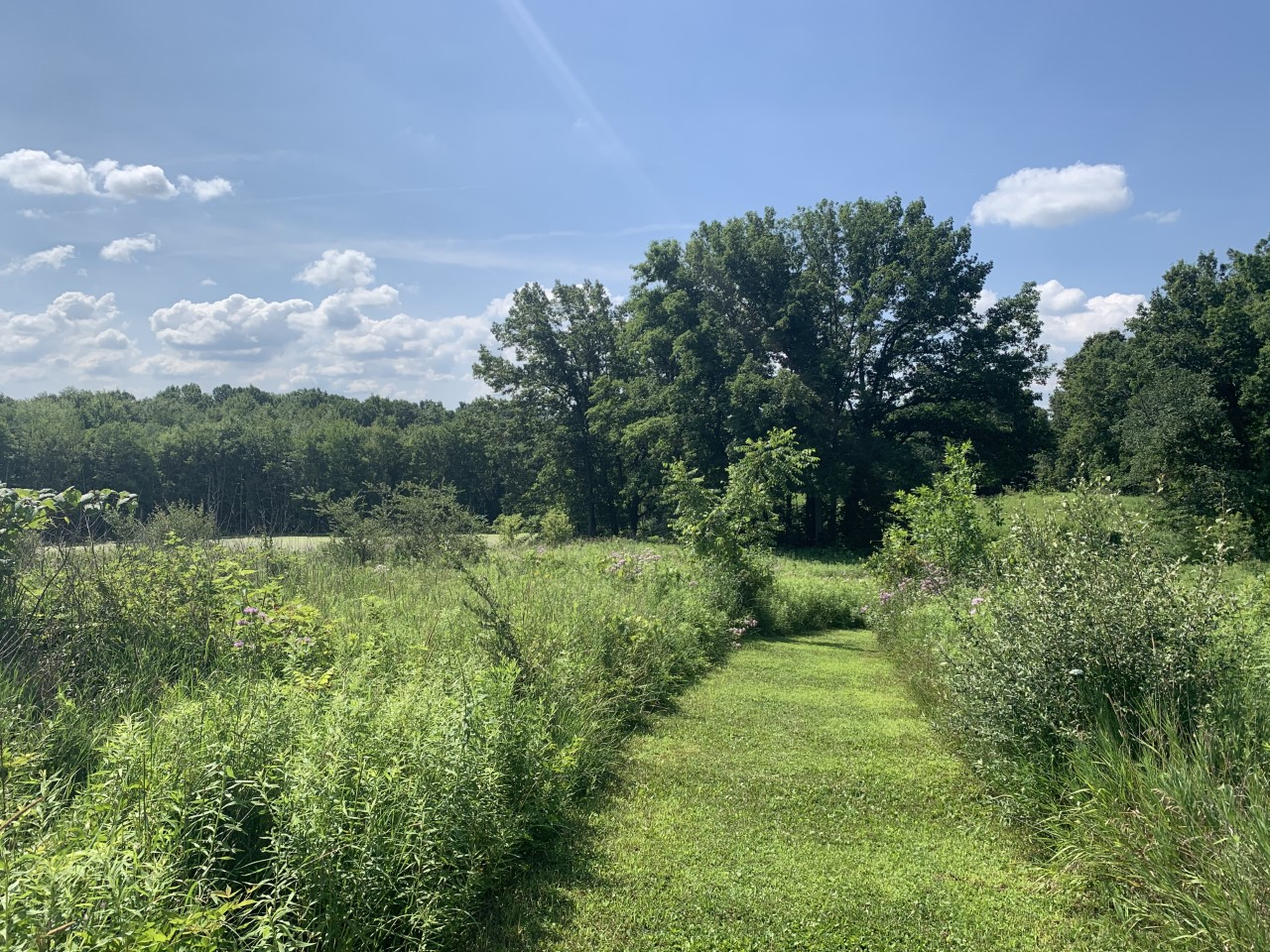This piece is written by Michigan Audubon Conservation Intern Molly Engelman. While she is focusing her conservation work at Bernard W. Baker Sanctuary in Bellevue, she is also developing a project to collect stories from a diverse group of people to highlight their experiences in the natural world. Stay tuned for information on how you can take part in the project and share it with others.
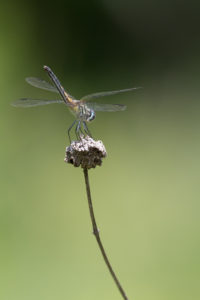
Dragonfly at Bernard W. Baker Sanctuary by Jerry Engelman
This summer, I decided to let my guard down. By this, I mean allowing myself to take up space in places where it wasn’t easy to picture myself. I think this could easily be contextualized by the fact that I accepted a position assisting in mosquito research in southwestern Michigan. Nothing against entomology, but if someone were to tell me back in February that I’d be spending my summer knee-deep in a bog vacuuming mosquitoes out of a box, I would have told them to tell a joke that’s actually funny. Yet here I am, lassoing CDC Light Traps 30 feet into red maple trees and concerning my friends with stories about Psorophora ferox and Coquillitidia perturbans.
As I began navigating this unexpected identity as a summertime mosquito researcher, I embarked too on a position with Michigan Audubon. I’ve had an interest in birds for some time, starting with my keen eye for the White-breasted Nuthatch who would frequent my backyard several summers ago. I used to take my dad’s camera out and sit by the feeder, squatting in the mulch until my feet went numb to get a poorly lit half-blurry photo of a Black-capped Chickadee. My dad, his interest piqued from the fact that his camera was always missing, soon picked up the hobby, and his vibrantly detailed shots of goldfinches and cardinals made me think it was best to leave the birds to him.
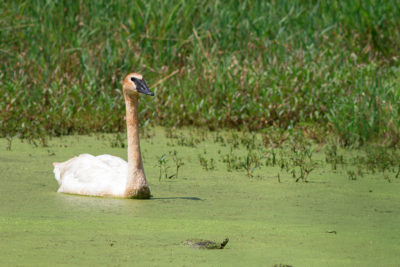
Trumpeter Swan with turtle at Bernard W. Baker Sanctuary by Jerry Engelman
From here, my pursuit of birds became mere background noise as I finished out high school. It wasn’t until my first semester of college when I enthusiastically accepted a position sitting in front of a computer processing thousands of duck photos for a grad student that I started to remember how much joy these little feathered animals brought me. This year, I learned of the term “birder” and came to recognize birdwatching as a more established hobby than I ever previously thought. Yet, despite my pristine waterfowl identification skills, I didn’t consider myself a birder. Perhaps I would say I was a birder* with the asterisk hinting at the fact that “I don’t actually know what I’m talking about.” I let my limited bird call recognition and songbird identification difficulties overshadow the connection I undoubtedly felt to birds and their diverse habitats. I thought, maybe once I achieved a degree in wildlife biology, or after years and years in the field, I could assume such a title. With so many highly experienced and decorated experts in the field and hobby of birding, I felt I should keep my growing knowledge in a shadow until I had a substantial repertoire of bird facts that could truly impress anyone.
I’ve come to realize, however, how misguided this ideology is. A person’s identity in the outdoors is not validated by how many species they can identify or how many field guides they own. My inability to tell a Song Sparrow from a Wood Thrush does not hinder the smile that spreads across my face as a troop of petite brown birds erupt from a buckthorn bush. In my time this summer exploring the Bernard W. Baker Sanctuary alone, I’ve let myself explore this concept of appreciating my pursuits of a deeper connection to nature without feeling as if I had to prove I belonged and was capable in the outdoors. Without feeling as though I had expectations to uphold, I felt my curiosity intensify, motivating me to visually untangle the multitude of prairie plants scattered through the sanctuary. I felt lighter on my feet yet more confident in my step, trusting myself enough even to brave the deer flies on a journey through the tamarack swamp. Rewarded by the elegant chime of the sanctuary’s Bald Eagles, I would feel my face rise into a cheeky smile with unprecedented ease, laughing out loud as I struggled to process the emotions of seeing our nation’s prized bird for the first time in the wild.
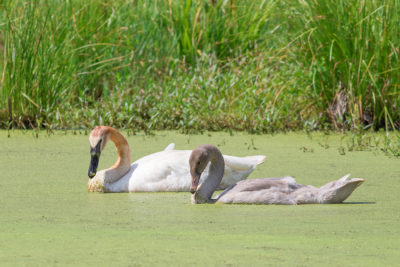
Trumpeter Swans at Bernard W. Baker Sanctuary by Jerry Engelman
I’ve known my whole life that I love nature, but I’ve never known that love as I’ve found it this summer. In reflecting on what’s been holding me away from this part of myself, I begin to think about my positionality in society and the implicit beliefs I’ve developed as a result. Growing up in the suburbs, I wasn’t exposed to much “wilderness” regularly. My escape to nature was the Rouge River; albeit a lovely natural feature I hold dear to my heart, I can’t ignore the crippling erosion, pollution, flash floods, and overall ominous murkiness of this river, which has drawn the EPA to label it as an Area of Concern. In my mind, true outdoor enthusiasts traversed pristine natural lands, made fire from flint and steel, knew the best plants to forage, and could tie every knot in the book. This image is far from my times spent watching Metro Detroit Mallards sift through beads of Styrofoam in search of wimpy submergent vegetation, and though I thoroughly enjoy the sight of a duck in any context, I told myself these experiences weren’t truly the “real deal.”
So, where did the aforementioned image of a true naturalist arise in my brain? Well, rereading my description, it seems I described something of a boy scout. Even as I typed the words “outdoor enthusiasts,” I did so while making a conscious effort to avoid the more common term of “outdoorsman.” To know the wild and survive in the wild, I imagined I had to be tough and passionate like Indiana Jones, with broad shoulders, scarred hands, and indifference to personal hygiene. But alas, I am a woman. I spend more money on makeup and earrings than I do backpacking supplies and Swiss army knives, and how could I possibly assert any right to the outdoors when my dainty cheetah print tops expose my skin to thorns and bee stings? Though I never wanted to admit it to myself, thoughts like these put up barriers within me, blocking my path of allowing myself to embark on pursuits such as my one through Big Marsh Lake. Consequently, I adopted a more understandable identity as the friendly neighborhood vegan girl reminding everyone to recycle. Yet, even as the president of my high school ecology club, I knew this identity I had presumed spoke more to others than it ever did to myself.
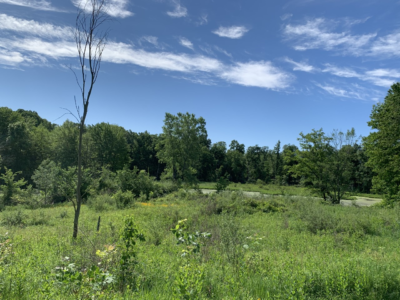
Lake at Bernard W. Baker Sanctuary by Molly Engelman
In discussing the obstacles of my societal position as a woman, it’s important to note the privileges of my positionality as well. I am a woman, and I am also white, and although some may doubt my capability in the outdoors, it’s highly unlikely I would get the cops called on me as I bird. As rightfully highlighted by Black Birders Week, the effects of the traditional outdoorsman and birder images go beyond gender. As more and more stories are shared of the oppressive realities Black people and people of color face in their pursuits of natural resource careers and hobbies, a blaring reality that parts of the outdoor community harbor a culture of unacceptance becomes increasingly prominent. I must also acknowledge my privilege of living in an upper-middle-class household. Though I observed the Rouge’s environmental degradation as I rode my bike eastward toward the city, I would return from each ride to a house with a well-manicured lawn of fresh-smelling grass, clean water coming from the tap, and minimal pest disturbances. The visuals of the trash-speckled Rouge would seamlessly fade from my mind as I turned my focus on National Geographic or a Netflix episode of Planet Earth.
In my case, and in many others, my privilege of living outside the harmful impacts of environmental degradation did not sway me from assuming a responsibility to conserve and protect natural spaces. It is this privilege, however, that presented this responsibility as a choice rather than a need. And just as many environmentalists actively choose to care about the Earth beyond their front yards, members of naturalist communities must actively choose to work toward the inclusion of others whose identities range far beyond the traditional mold of who we’ve been conditioned to picture in the great outdoors. In the interest of birds and those who fight to save them, and in a time where climate change and species extinction is exceeding rapidly, it is in the best interest of the birding community to extend our hands to any and everyone who wishes to make nature a prominent part of their lives.
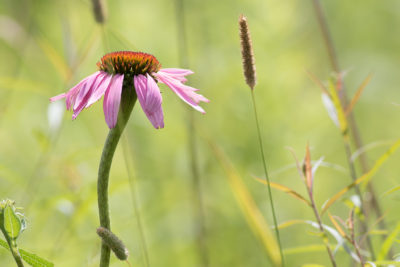
Purple coneflower at Bernard W. Baker Sanctuary by Jerry Engelman
Of all the realizations I’ve come to this summer, perhaps the most important has been recognizing the integrity of Michigan Audubon’s mission to connect birds and people for the benefit of both. I’ve had great fortune in my life to have had opportunities to explore places and meet people who encourage this journey of recognizing my true potential as a birder and woman in STEM. The gratitude that fills me in response to someone who extends a hand with an “I know you can do this” fuels me to believe in the power of active compassion and outreach. As the birding community continues to show strength and dedication to defending the persistence of our feathered neighbors, I know a synergistic strength can be found in fostering that care into our human relationships as well.
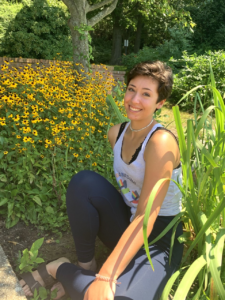 Molly Engelman is a sophomore at Michigan State University pursuing a degree in Fisheries and Wildlife. Growing up in Plymouth, Mich., Molly got involved with the Friends of the Rouge River and began developing a passion for the conservation of aquatic ecosystems. Since being at MSU, Molly has furthered her interests by assisting a master’s student in waterfowl research and becoming involved with the Fisheries and Wildlife Club, along with the MSU chapter of Ducks Unlimited. This summer, Molly has veered slightly off the wildlife course by assisting the research of Eastern Equine Encephalitis and its associated mosquito vectors in bog habitats of southwestern Michigan.
Molly Engelman is a sophomore at Michigan State University pursuing a degree in Fisheries and Wildlife. Growing up in Plymouth, Mich., Molly got involved with the Friends of the Rouge River and began developing a passion for the conservation of aquatic ecosystems. Since being at MSU, Molly has furthered her interests by assisting a master’s student in waterfowl research and becoming involved with the Fisheries and Wildlife Club, along with the MSU chapter of Ducks Unlimited. This summer, Molly has veered slightly off the wildlife course by assisting the research of Eastern Equine Encephalitis and its associated mosquito vectors in bog habitats of southwestern Michigan.
Molly is thrilled to be a part of the Michigan Audubon team as they follow their mission to conserve native birds and connect people with nature through such efforts. Her internship is focused on the Bernard W. Baker Sanctuary as she aims to promote birding as an all-inclusive hobby that is safe and accessible to everyone. Molly loves tea, cycling, yoga, and exploring natural spaces with friends. Although she is easily excited about waterfowl, Molly’s favorite non-game bird is the Piping Plover.

